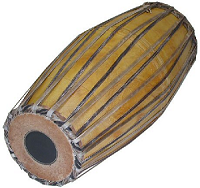The Mrudangam is a percussion instrument from India of ancient origin. It is the primary rhythmic accompaniment in a Carnatic music ensemble. Alternate spellings include “mridangam”, “mrdangam”, “mritangam” and “miruthangam in Tamil”.
The mrudangam is also played in Carnatic concerts in countries outside of India, including Sri Lanka, Singapore, Malaysia, Australia, United Kingdom, Canada, and the United States. During a percussion ensemble, the mridangam is often accompanied by the ghatam, kanjira, and the morsing.
The mridangam is a double-sided drum whose body is usually made using a hollowed piece of jackfruit wood about an inch thick. The two mouths or apertures of the drum are covered with a goatskin and laced to each other with leather straps around the circumference of drum. These straps are put into a state of high tension to stretch out the circular membranes on either side of the hull, allowing them to resonate when struck. These two membranes are dissimilar in width to allow for the production of both bass and treble sounds from the same drum.
The bass aperture is known as the thoppi or eda bhaaga and the smaller aperture is known as the valanthalai or bala bhaaga. The smaller membrane, when struck, produces higher pitched sounds with a metallic timbre. The wider aperture produces lower pitched sounds. The goat skin covering the smaller aperture is anointed in the center with a black disk made of rice flour, ferric oxide powder and starch. This black tuning paste is known as the satham or karanai and gives the mridangam its distinct metallic timbre.
The combination of two inhomogeneous circular membranes allows for the production of unique and distinct harmonics.
Immediately prior to use in a performance, the leather covering the wider aperture is made moist and a spot of paste made from rice flour and water is applied to the center, which lowers the pitch of the left membrane and gives it a very powerful resonating bass sound. The artist tunes the instrument by varying the tension in the leather straps spanning the hull of the instrument. This is achieved by placing the mridangam upright with its larger side facing down, and then striking the tension bearing straps located along of circumference of the right membrane with a heavy object (such as a stone). A wooden peg is sometimes placed between the stone and the mridangam during the tuning procedure to ensure that the force is exerted at precisely the point where it is needed. Striking the periphery of the right membrane in the direction toward the hull raises the pitch, while striking the periphery from the opposite side (moving away from the hull) lowers the pitch. The pitch must be uniform and balanced at all points along the circumference of the valanthalai for the sound to resonate perfectly. The pitch can be balanced with the aid of a pitch pipe or a tambura. The larger membrane can also be tuned in a similar manner, though it is not done as frequently. Note that since the leather straps are interwoven between both the smaller and larger aperture, adjusting the tension on one side often can affect the tension on the other.
